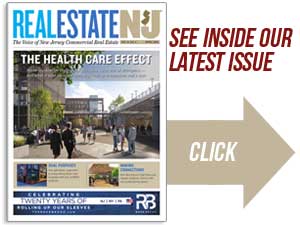Robert Towers in East Orange, which traded for $22 million in May under a deal brokered by Marcus & Millichap
By Joshua Burd
Investor appetite for northern New Jersey’s multifamily sector showed few signs of slowing down in 2018, causing buyers to explore new frontiers in the market, move more aggressively and expand into other asset classes.
That’s according to brokers with Marcus & Millichap, who say that out-of-market buyers from New York City and elsewhere have begun to pivot in recent months in order to find new deals. Not only are investors looking at less-heralded submarkets such as Essex and Union counties, but they are increasingly willing to forgo typical due diligence periods for both multifamily and commercial properties.
Fahri Ozturk and Richard Gatto, who lead an investment sales team based in the firm’s Saddle Brook office, say the growth of Hudson County has been a driving force behind the new strategies. The intense competition for deals has pushed up pricing and, in turn, compressed the yields that investors can achieve in places such as Jersey City, Hoboken and Weehawken, causing them to look farther west.

“The next untapped market was Essex County,” said Gatto, a broker in Marcus & Millichap’s National Multi Family Housing Group. “And when you see the growth that Newark is having through development and gentrification downtown, that’s starting to change Essex County and particularly places like East Orange.”
For instance, the Ozturk and Gatto team earlier this year brokered the sale of Robert Towers, an 11-story, 206-unit multifamily property at 60 South Munn Ave. in East Orange. Ozturk noted at the time that the property sold for $22 million after drawing 17 offers in 30 days, including five from out-of-market buyers.
In addition to the Newark ripple effect, Gatto said East Orange benefits from its accessibility and mass transit options, which include a 24-minute train ride to Midtown Manhattan. Those fundamentals have translated to both new construction and renovations to existing apartment buildings in the city to create appealing options for renters.
“We believe there’s a real story to tell there,” Gatto said. “And a lot of the investors that we’re seeing come into the market are extremely bullish on places like East Orange going forward because of that.”
Both East Orange and Irvington are providing attractive value-add opportunities for buyers, especially with developers now turning to ground-up construction in both places. Newly built, Class A apartment buildings in the submarkets have performed well at monthly rents of around $1,650, Gatto said, which has created large gap between those properties and Class C apartments that are in need of upgrades.
That gap can be around $600, he said, “so if you can provide a tenant with a good, clean place to live and put in some nice updates and finishes, you can achieve some pretty good rents there.”
“The buyers want stability and the ability to go in and create value,” Gatto said, “and I think that’s really where multifamily is so attractive because they can easily wrap their heads around how to add value in multifamily.”

The “expansive growth” of East Orange and other nearby municipalities has impacted the investment sales market in other ways. For instance, Ozturk said buyers are willing to close deals with shorter due diligence periods or very little due diligence at all.
And in many cases, those buyers are paying cash and willing to enter into a contract without financing contingencies.
That represents a change from around three years ago, when due diligence periods of 30 to 45 days were more commonplace. That is true for not only multifamily deals in Hudson County, but those in Essex County and for suburban office buildings.
“With the (multifamily) product being so hot, that’s understandable, but we’re also seeing that in good, quality suburban stabilized office product,” said Ozturk, a vice president for investments with Marcus.
The ability to find yield and cash flow in Class B suburban office buildings has attracted new investors in northern New Jersey, Gatto and Ozturk said, including many buyers that have historically focused on apartments. For an owner that has just unloaded an underperforming or noncore residential building, an office building with long-term leases and strong tenants can be an intriguing alternative.
The Marcus & Millichap team has closed about $50 million worth of office transactions in recent months, almost all of them involving buyers who also own multifamily assets, Ozturk said. The office sector has become increasingly attractive due to northern New Jersey’s low unemployment rate, vacancy rates that have declined for five consecutive years and a more reliable income stream than earlier in the cycle.
“For the first time in a long time, with office product the buyers actually have a predictable cash flow,” Ozturk said. “Five years ago or seven years ago, that wasn’t the case.”










